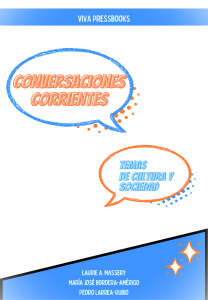About the book: description, design and teaching methodology
Laurie Massery

This online textbook allows students to read, review and discuss current, interesting, thought-provoking and entertaining articles that will undoubtedly elicit conversation and friendly debate among classmates. Topics, including spirituality, family design, life choices and social norms are introduced, along with interactive exercises that allow students to practice vocabulary and grammar as they read the texts. This online resource includes instructions on how to apply the CRGG-C Framework that facilitates conversation among students by assigning roles and responsibilities while also eliciting oral and written feedback in Spanish see Making conversation stick.[1] Throughout the course, we also suggest that instructors incorporate peer evaluation activities and progress reports based on feedback provided by fellow students. For more information on how to successfully use peer evaluation activities in a foreign language conversation course, please read The power of peer evaluation: rethinking pedagogy in L2 conversation courses[2].
Apart from small group discussions and pair work, one the most fundamental aspects of the course design, is the successful completion of homework assignments prior to attending class. Following a flipped classroom design, we recommend that the instructor assign between 5 and 8 questions based on the material planned for the following class. Using a course management system, such as Canvas, Moodle or Blackboard, we suggest that the instructor ensure that students answer questions thoroughly and per the specific set of criteria available in the corresponding rubric. The success of small group conversation among the students is founded on the thorough research and preparation of their (i.e., students’) answers. Furthermore, by preparing answers ahead of time, students have the opportunity to organize their ideas, learn new vocabulary and think carefully about how they will articulate their thoughts in subsequent conversations with their peers. Finally, we recommend that students write between 1 to 2 pages of text in the target language (12 font, single spaced) for each class, which may vary depending on the topic.
Conversaciones Corrientes is not a linear textbook. Therefore, instructors and students are able pick and choose which activities they would like to use, without having to depend on previously assigned articles in a given chapter. With that said, the chapters are loosely based on broad topics, including personal histories, life-changing decisions, controversial topics of our time, diversity in the Spanish-speaking world, and bilingualism. The book is designed to provide instructors and students with the freedom to select topics that best suit their needs and interests. Consequently, it is possible that this book may not be used in its entirety in one semester, but rather as a point of departure for a course in Spanish conversation.
For additional activity designs, see suggestions for classroom activities.

